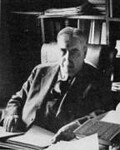Edward L. Thorndike

Edward L. Thorndike
(1874-1949)Psychologist
Education
- Wesleyan University (BS, 1895)
- Harvard University (MA, 1897) - Worked with William James
- Columbia University (Ph.D., 1898) - Under James M. Cattell
- Assistant Professor of Pedagogy at Case Western Reserve University (1898)
- Faculty at Teachers College, Columbia University (1899-1940)
- President of American Psychological Association (1912)
- 2nd President of Psychometric Society
- President of American Association for the Advancement of Science (1934)
- William James Lecturer, Harvard University (1942-1943)
Major Contributions
- During his 55-year career, he published about 500 books and articles on diverse as learning in fish, methods of statistical analysis and the elements of aesthetic quality in urban life.
- Studied animal intelligence (known for his 'cats in a puzzle box' experiments on Trial and Error)
- Applied animal to human educational experience; he was once the leader in this field.
- Constructed a scale to measure children's handwriting (1910) and a table of word-frequency in English (1944).
 Ideas and Interests
Ideas and InterestsThorndike's early studies with animal behavior led him to declare his Law of Effect.
The Law of Effect states that a) Responses to a situation that are followed by satisfaction are strengthened; and b) Responses that are followed by discomfort are weakened. Thorndike's Law of Exercisecontinued this line of thought; a) Stimulus-response connections that are repeated are strengthened, and b) Stimulus -response connections that are not used are weakened. Thorndike later conducted research that provided evidence that the Law of Exercise lacked validity. Thorndike characterized the two most basic intelligences as Trial-and-Error and Stimulus-Response Association.
Thorndike and his students used objective measurements of intelligence on human subjects as early as 1903. By the time the United States entered WWI, Thorndike had developed methods for measuring a wide variety of abilities and achievements. During the 1920's he developed a test of intelligence that consisted of completion, arithmetic, vocabulary, and directions test, known as the CAVD. This instrument was intended to measure intellectual level on an absolute scale. The logic underlying the test predicted elements of test design that eventually became the foundation of modern intelligence tests.
Thorndike drew an important distinction among three broad classes of intellectual functioning. Standard intelligence tests measured only "abstract intelligence". Also important were "mechanical intelligence - the ability to visualize relationships among objects and understand how the physical world worked", and social intelligence - the ability to function successfully in interpersonal situations". Thorndike called for instruments to develop measures for these other types of intellect.
Thorndike developed psychological connectionism. He believed that through experience neural bonds or connections were formed between perceived stimuli and emitted responses; therefore, intellect facilitated the formation of the neural bonds. People of higher intellect could form more bonds and form them more easily than people of lower ability. The ability to form bonds was rooted in genetic potential through the genes' influence on the structure of the brain, but the content of intellect was a function of experience. Thorndike rejected the idea that a measure of intelligence independent of cultural background was possible.
Thorndike proposed that there were four general dimensions of abstract intelligence:
- Altitude: the complexity or difficulty of tasks one can perform (most important)
- Width: the variety of tasks of a give difficulty
- Area: a function of width and altitude
- Speed: the number of tasks one can complete in a given time .

The Work Of Edward L. Thorndike
Cats In Puzzle Boxes
Edward L. Thorndike (1874-1949) being an early pioneer in conditioning research, studied the behaviour of cats in a chamber called the puzzle box. The cat was confined inside the chamber. A number of devices inside the chamber included rings, loops of wire, and panels. The cat's task was to learn to escape from the box. However, only by pulling a particular device could the cat escape. Since there were several devices, the task was difficult. The cat ususally escaped after a number of minutes.
As trials proceeded, the escape response occurred more quickly. The learning was gradual and orderly. Thorndike concluded that the cats did not use reasoning to solve this problem but rather slow trial-and-error learning. He stated this formally as the law of effect: responses followed by a satisfying state of affairs were gradually stamped in (developed) as habits; responses followed by an annoying state of affairs were gradually stamped out as habits(eliminated from the animal's behavioural repertoire).
No comments:
Post a Comment